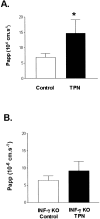Interferon-gamma expression by intraepithelial lymphocytes results in a loss of epithelial barrier function in a mouse model of total parenteral nutrition
- PMID: 12170028
- PMCID: PMC1422569
- DOI: 10.1097/00000658-200208000-00011
Interferon-gamma expression by intraepithelial lymphocytes results in a loss of epithelial barrier function in a mouse model of total parenteral nutrition
Abstract
Objective: To determine the etiology of the loss of epithelial barrier function observed with the administration of total parenteral nutrition (TPN) in a mouse model.
Summary background data: Removal of enteral nutrition with the administration of TPN is associated with a loss of intestinal epithelial barrier function. The etiology of this barrier loss is not clear. Because intraepithelial lymphocytes (IELs) produce a number of cytokines that may alter epithelial permeability, the authors investigated IEL cytokine expression in a mouse model of TPN.
Methods: Adult C57BL/6 mice received TPN or enteral diet for 7 days. IELs were subsequently harvested and the mRNA expression of cytokines was measured. Epithelial barrier function was assessed in vitro with 51Cr-EDTA in Ussing chambers and was expressed as the permeability coefficient (Papp).
Results: IEL mRNA expression of interferon-gamma (IFN-gamma) rose from 0.14 +/- 0.07 in the control (enterally fed) group to 0.44 +/- 0.11 attomoles/microL in the TPN group (P <.05). Transforming growth factor-beta1 declined slightly but not significantly, from 0.75 +/- 0.35 to 0.55 +/- 0.18 attomoles/microL in the control and TPN groups, respectively. Epithelial barrier function declined significantly with TPN compared to controls. To assess the relevance of IFN-gamma changes, permeability in IFN-gamma knockout mice was studied. Barrier function was significantly higher in IFN-gamma knockout mice on TPN compared to C57BL/6 mice that received TPN.
Conclusions: IEL cytokine expression changes significantly with TPN administration. The partial correction with IFN-gamma knockout mice suggests that an upregulation of IFN-gamma expression is one mechanism responsible for the loss of the epithelial barrier associated with TPN.
Figures





References
-
- Deitch E. The role of intestinal barrier failure and bacterial translocation in the development of systemic infection and multiple organ failure. Arch Surg 1990; 125: 403–404. - PubMed
-
- Buchman A, Moukarzel A, Bhuta S, et al. Parenteral nutrition is associated with intestinal morphologic and functional changes in humans. JPEN 1995; 19: 453–460. - PubMed
-
- Purandare S, Offenbard K, Westerom B. Increased gut permeability to fluorescein isothiocyanate-dextran after total parenteral nutrition in the rat. J Gastroenterol 1989; 24: 678–682. - PubMed
-
- Khan J, Iiboshi Y, Nezu R, et al. Total parenteral nutrition increases uptake of latex beads by Peyer’s patches. JPEN 1997; 21: 31–35. - PubMed
Publication types
MeSH terms
Substances
Grants and funding
LinkOut - more resources
Full Text Sources
Research Materials

